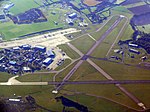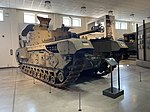Bradenstoke
EngvarB from August 2019OpenDomesdayVillages in Wiltshire

Bradenstoke is a village in Wiltshire, England, lying to the north of the former RAF Lyneham airbase and 1.5 miles (2.4 km) northwest of Lyneham. Originally lying within Braydon Forest, the "stoke" means "settlement".Largely consisting of a long and narrow main street, the village has a church, one chapel (it used to have two chapels but the Methodist Chapel has been converted into a dwelling), a village hall and a pub. The Post Office closed in 2008.
Excerpt from the Wikipedia article Bradenstoke (License: CC BY-SA 3.0, Authors, Images).Bradenstoke
Hollow Way,
Geographical coordinates (GPS) Address Nearby Places Show on map
Geographical coordinates (GPS)
| Latitude | Longitude |
|---|---|
| N 51.514 ° | E -1.999 ° |
Address
Hollow Way
Hollow Way
SN15 4ES , Lyneham and Bradenstoke
England, United Kingdom
Open on Google Maps








